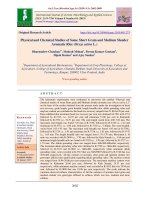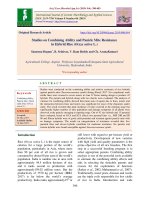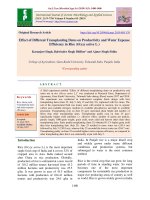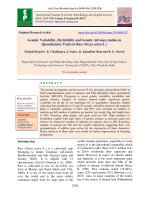Effect of nitrogen application through urea and azolla on growth and biological yield of rice (Oryza sativa L.) in acidic soil of Meghalaya
Bạn đang xem bản rút gọn của tài liệu. Xem và tải ngay bản đầy đủ của tài liệu tại đây (156.89 KB, 6 trang )
Int.J.Curr.Microbiol.App.Sci (2018) 7(7): 3135-3140
International Journal of Current Microbiology and Applied Sciences
ISSN: 2319-7706 Volume 7 Number 07 (2018)
Journal homepage:
Original Research Article
/>
Effect of Nitrogen Application through Urea and Azolla on Growth and
Biological Yield of Rice (Oryza sativa L.) in Acidic Soil of Meghalaya
Shubham Singh, Sanjay Swami* and G.N. Gurjar
School of Natural Resource Management, College of Post Graduate Studies,
Central Agricultural University, Umiam-793103, Meghalaya, India
*Corresponding author
ABSTRACT
Keywords
Azolla
incorporation,
Chemical fertilizers,
Integrated nutrient
management, Rice,
Yield, Acidic soil
Article Info
Accepted:
24 June 2018
Available Online:
10 July 2018
A field experiment was conducted during kharif 2017-18 to investigate the effect of
nitrogen application through urea and azolla on growth, yield of rice (Oryza sativa L.) and
temporal soil phosphorus availability with six treatments viz., control (T1), Azolla
incorporation @ 16000 kg ha -1 (T2), 30 kg N ha-1through urea(T3), 60 kg N ha-1through
urea(T4), 30 kg N ha-1through urea+ Azolla incorporation @ 16000 kg ha-1 (T5) and 60 kg
N ha-1through urea with Azolla incorporation @ 16000 kg ha -1(T6) . The experiment was
laid out in RBD and replicated four times. The experimental soil was having pH 5.1, SOC
1.75 per cent, available N, P and K as 288.62, 17.23and 201.46kg ha-1, respectively. The
experimental results revealed that the application of 60 kg N ha -1 through urea along with
azolla incorporation @ 16000 kg ha-1 (T6) recorded highest plant height (118.67 cm) at 90
DAT of rice which is significantly superior over control (98.17 cm) with 17.27 per cent
increase. Similarly, 60 kg N ha-1 through urea with azolla incorporation @ 16000 kg ha -1
produced highest grain and straw yield i.e. 4.2 t ha -1 and 7.68 t ha-1 followed by T5 and T4.
Further, it was observed that the grain yield obtained in T 2 was statistically at par with T3.
The grain and straw yield obtained in T 4 was also found statistically at par with the values
obtained in T5.
Introduction
Rice is the most widely consumed staple food
for a large part of world’s human population,
especially in Asia. It is the agricultural
commodity with the third highest worldwide
production of 741.5 million tones in 2014
(FAOSTAT, 2014).In India, it has total
production of 106.5 Mt whereas in Meghalaya
it is limited to 2.8 lakh tones (DES, 2015). The
food demand is on the increase, the factor
productivity and rate of response of crops to
applied fertilizers under intensive farming
conditions are continuously declining with
every passing year. The energy crisis and high
fertilizer costs have created considerable
concern and the use of organic materials as
sources of plant nutrients for lowland rice.
The success of rice production depends mostly
on an efficient and economic supply of N
apart from irrigation. The use efficiency of N
from fertiliser sources in lowland rice is
notoriously low around 30 to 50 per cent,
3135
Int.J.Curr.Microbiol.App.Sci (2018) 7(7): 3135-3140
because of its loss from soils through various
chemical and biochemical processes. It has,
therefore, become necessary to look for
alternative renewable resources to meet at
least a part of the N demand of rice crops. Nfixing
blue-green
algae
(BGA)
or
cyanobacteria and Azolla, have been shown to
be the most important in maintaining and
improving the productivity of rice fields (Raja
et al., 2012). Azolla is a free-floating water
fern that floats in the water and fixes
atmospheric nitrogen because of its
association with the nitrogen fixing
cyanobacterium Anabaena. It has also been
reported in literature that an Azolla-Anabena
system is ideal for the cultivation of rice under
tropical conditions because of its ability to fix
atmospheric nitrogen and capacity to multiply
at faster rates. Keeping these facts in view, the
present investigation was carried out to study
the effect of nitrogen application through urea
and azolla incorporation on growth and yield
of rice (Oryza sativa L.) in acidic soil of
Meghalaya.
the agronomic practices were followed for
raising paddy crop. The nutrient content of N,
P and K in azolla was 4.2, 0.6 and 1.9 per
cent, respectively on dry weight basis.
Materials and Methods
The plant height (cm) of rice under various
treatments was recorded at four time intervals
of crop growth i.e. 30, 60, 90 days after
transplanting and at maturity (Table 1). The
significant variations were recorded in plant
height due to the treatment combinations at
each time interval i.e. 30, 60, 90 DAT and at
maturity. The application of 60 kg N
ha-1through
urea
along
with
azolla
-1
incorporation @ 16000 kg ha (T6) recorded
highest plant height (118.67 cm) at 90 DAT of
rice which is significantly superior over
control (98.17 cm) with 17.27 per cent
increase. The plant height also increased with
30 kg N ha-1through urea + azolla
incorporation @ 16000 kg ha-1(T5) over the
sole application of 30 kg N ha-1 through urea
(T3) by 8.95 per cent. Similarly, the plant
height also increased in T6 (60 kg N ha-1
through urea with azolla incorporation @
16000 kg ha-1 over T4 with sole application of
The experiment was conducted at Research
Farm of the College of Post-Graduate Studies
(CPGS), Umiam, Ri-Bhoi district of
Meghalaya located at 91018’ to 92018’ E
longitude and 25040’ to 26020’ N latitude with
an altitude of 950 m above the mean sea level
during kharif season of 2017. The
experimental soil was having pH 5.1, SOC
1.75 per cent, available N, P and K as 288.62,
17.23 and 201.46 kg ha-1, respectively. The
field
experiment
was
conducted in
Randomized Block Design (RBD) having six
treatments and four replications viz., control
(T1), Azolla incorporation @ 16000 kg ha-1
(T2), 30 kg N ha-1 through urea (T3), 60 kg N
ha-1 through urea (T4), 30 kg N ha-1 through
urea + Azolla incorporation @ 16000 kg ha-1
(T5) and 60 kg N ha-1 through urea with
Azolla incorporation @ 16000 kg ha-1 (T6). All
Plant height was measured from ground level
to the topmost node of the plant from five
representative hills of each plot. The average
height of plants was expressed in cm. The data
recorded at 30, 60, 90 days after transplanting
and at maturity. Grain, straw and biological
yield of rice were recorded after the harvest of
the crop when optimum moisture content was
achieved and expressed in tha-1. Harvest index
was calculated by dividing the economic yield
(grain) by biological yield (grain + straw) as
suggested by Donald (1976). The data
recorded for various parameters were analysed
statistically by following procedure of Gomez
and Gomez (1984).
Results and Discussion
Plant height (cm)
3136
Int.J.Curr.Microbiol.App.Sci (2018) 7(7): 3135-3140
60 kg N ha-1 through urea to the tune of 6.61
per cent at maturity. Similar results were also
reported by Akhter et al., (2002) in rice
indicating that the combined application of
azolla biomass plus urea-N significantly
increased the plant height. However, the
present findings are in partial agreement with
the result of Paul et al., (2016) who reported
that the combined use of organic and chemical
sources of plant nutrients in varying
proportions resulted better growth of the
plants compare to chemical fertilizers alone.
The increase in height with increasing levels
of N be the reason for more plant height in T4
(60 kg N ha-1through urea) than T3 (30 kg N
ha-1 through urea). The result from the present
study confirms the findings of Reddy et al.,
(1987) and Akanda et al., (1986). Availability
of nitrogen throughout the growth stages
might be responsible for the better
performance of rice (Islam et. al., 2009).
Nitrogen in azolla becomes available after its
decomposition in the soil. About half of
nitrogen was mineralized within 3 weeks of
water-logged incubation at 30oC and two
thirds of nitrogen was released after 6 or 8
weeks of incubation (Moro et. al., 2015). This
might be the reason for increased plant height
in treatments with azolla incorporation.
Yield of rice (t ha-1)
Grain yield of rice was significantly increased
with different level of urea and azola
applications under different treatments (Table
2). It was found that T6 with the application of
60 kg N ha-1 through urea + azolla
incorporation @ 16000 kg ha-1 produced
highest grain yield (4.2 t ha-1) which was
trailed by T5 (30 kg N ha-1 through urea +
azolla incorporation @ 16000 kg ha-1) with
3.77 t ha-1. The per cent increase in grain yield
obtained in T5 over T3 (sole application of 30
kg N ha-1 through urea) was 17.81 per cent
whereas, the per cent increase in T6 over T4
(sole application of 60 kg N ha-1 through urea)
was recorded as 17.65. These results
confirmed the earlier findings of Singh (1977)
and Mahmud et al., (2016) who reported that
the incorporation of fresh or dry azolla
biomass into the soil always increased grain
and straw yield of rice. In the same way,
Shanmugasundaram (1990) also found that
azolla hybrid along with fertilizer nitrogen
increased the grain yield of rice. Significant
increase in grain yield of rice was also
reported by Kannaiyan (1978) when azolla
was used along with 100 kg N ha-1 as USG
(Urea super granule).
Table.1 Effect of nitrogen application through urea and azolla on plant height (cm) of rice (Oryza
sativa L.) at different time intervals
Treatments
T1-Control
T2-Azolla incorporation @ 16000 kg ha-1
T3- 30 kg N ha-1through urea
T4-60 kg N ha-1 through urea
T5-30 kg N ha-1 through urea+
Azolla incorporation @ 16000 kg ha-1
T6-60 kg N ha-1 through urea+
Azolla incorporation @ 16000 kg ha-1
SE(m)±
CD (P=0.05)
30 DAT
46.08
49.75
50.75
54.50
58.67
60 DAT
72.92
73.83
75.50
77.83
80.25
90 DAT
98.17
100.67
104.33
110.83
114.58
At Maturity
98.17
100.67
104.33
110.83
114.58
60.17
82.58
118.67
118.67
2.47
7.43
2.78
8.38
4.75
14.31
4.75
14.31
3137
Int.J.Curr.Microbiol.App.Sci (2018) 7(7): 3135-3140
Table.2 Effect of nitrogen application through urea and azolla on grain, straw, biological yield (t
ha-1) of rice and harvest index (per cent)
Treatment
T1-Control
T2-Azolla incorporation @ 16000 kg ha-1
T3- 30 kg N ha-1through urea
T4- 60 kg N ha-1 through urea
T5- 30 kg N ha-1 through urea +
Azolla incorporation @ 16000 kg ha-1
T6- 60 kg N ha-1 through urea +
Azolla incorporation @ 16000 kg ha-1
SE(m)±
CD(P=0.05)
Grain
(t ha-1)
2.73
2.95
3.20
3.57
3.77
Straw
(t ha-1)
5.85
6.11
6.51
7.04
7.42
Biological
Yield (t ha-1)
8.58
9.05
9.71
10.61
11.19
Harvest
Index (%)
31.82
32.60
32.96
33.65
33.69
4.20
7.68
11.88
35.35
0.21
0.62
0.39
1.19
0.50
1.47
2.00
6.02
In the present investigation also, the higher
straw yield (7.68 t ha-1) was recorded in T6
(60 kg N ha-1 through urea + azolla
incorporation @ 16000 kg ha-1) while the
minimum straw yield (5.85 t ha-1) was
recorded in T1 (control). Again, the results
obtained are in agreement with Kannaiyan
and Rajeswari (1983) and Islaim et al., (1984)
that azolla application increased the yield
components of rice. It has been established
well that azolla is capable of increasing the
grain yields of rice significantly (Lumpkin
and Plucknett 1980). The reason for increased
yield components and grain yield of rice with
azolla incorporated treatments might be due
to higher availability of azolla nitrogen to rice
plants. When azolla is incorporated into the
flooded
soil,
it
undergoes
active
decomposition and the nitrogen released in
ammonical form is readily absorbed by the
rice plants. The low yield reported in azolla
unincorporated treatments could be due to a
lower rate of decomposition and possibly less
availability of Azolla-N to rice plants.
Moreover, Ito and Watanabe (1985) reported
that rice plants absorbed more than 50 per
cent of 15N labelled Azolla-N incorporated at
the time of transplanting and when azolla was
kept on the surface of water, less than 10 per
cent of its N was available to the rice plants.
Hence, the efficiency of azolla bio-fertilizer
could be increased by incorporating it into the
rice soil, which avoids losses of nitrogen and
higher yield response could be obtained from
rice plants. Increased dry matter and grain
yields observed in the present study with
azolla application have been reported by
several workers (Singh, 1977; Talley et al.,
1977; Shukla et al., 2016; Rains & Talley,
1978).
The present investigation demonstrated that
application of 60 kg N ha-1 through urea with
azolla incorporation @ 16000 kg ha-1 (T6) was
found most effective in increasing grain and
straw yield of rice as compared to sole
application of azola or nitrogen application
through urea. Therefore, the farmers of
Meghalaya may be advised to use 60 kg N
ha-1 through urea in combination with azolla
incorporation @ 16000 kg ha-1 for getting
optimum production of rice in acid soils.
Further, it indicates that farmers can manage
around 30 kg N through incorporation of
azolla @ 16000 kg ha-1 in rice crop instead of
supplying through nitrogenous fertilizers
keeping in view of sustainability of soil
health.
3138
Int.J.Curr.Microbiol.App.Sci (2018) 7(7): 3135-3140
Acknowledgement
The laboratory facility provided by School of
Natural Resource Management, CPGS, CAU,
Umiam for carrying out soil and plant
analysis for present study is duly
acknowledged.
References
Akanda, M.R.U., Eunus, M., Islam, M.A. and
Ali, M.I. (1986). Nitrogen application
timing and performance of BR4
transplant aman rice. Bangladesh J.
Agric., 11 (1): 39-43.
Akhter, S., Mian, M.H., Kadeer, M.A. and
Begum, S.A. (2002). Combination of
azolla and urea Nitrogen for
satisfactory production of irrigated
Boro rice (BRRI Dhan 29). Pakistan
J. Agron., 1(4): 127-130.
DES (2015). Annual Progress Report,
Directorate of Economic Survey,
Govt. of India, pp. 54-129.
Donald, C.M., and Hamblin, J. (1976). The
biological yield and harvest index of
cereals as agronomic and plant
breeding criteria. Advances Agron.,
28: 361-405.
FAOSTAT (2014). FAO Global Statistical
Yearbook, Food and Agriculture
Organization of the United Nations.
Islam, A., Molla, A.L. and Hoque, S. (1984).
Azolla and blue green algae as
alternative sources of N for rice and
their mineralization in soils of
Bangladesh. Ind. J. Agric. Sci., 54:
1056-106.
Islam,
M.S.,
Hasanuzzamanb,
M.,
Rokonuzzamanc, M.
K. Nahard
(2009). Effect of split application of
nitrogen
fertilizer
on
morphophysiological parameters of
rice genotypes. Int. J. Plant Prod., 3
(1): 51-62.
Ito, O. and Watanabe, I. (1985). Availability
to rice plants of nitrogen fixed by
Azolla. Soil Sci. Plant Nutr., 31: 91104.
Kannaiyan, S. (1978). Nitrogen fixation by
Azolla. A brief Review. Farm Sci. 5:
19-25.
Kannaiyan, S. and Rajeswari, N. (1983).
Comparative effect of fertilizer
nitrogen and Azolla biofertilizer on
the tiller production of rice. Sci. Cult.,
49:2 45-246.
Lumpkin, T. A. and Plucknet, D. L. (1980).
Azolla: botany, physiology and use as
a green manure. Econ. Bot., 34: 111153.
Mahmud, A.J., Shamsuddoha, A.T.M. and
Haque, M.N. (2016). Effect of
Organic and Inorganic Fertilizer on
the Growth and Yield of Rice (Oryza
sativa L.). J. Nat. Sci., 14(2): 45-54.
Moro, B.M., Nuhu, I.R, Ato, E. and
Nathanial, B. (2015). Effect of
nitrogen rates on the growth and yield
of three rice (Oryza sativa L.) varieties
in rain-fed lowland in the forest agroecological zone of Ghana. Int. J.
Agric. Sci., 5 (7): 878-885.
Paul, S.K., Islam, M.S., Sarkar, M.A.R., Das,
K.R. and Islam, S.M.M. (2016).
Impact of variety and levels of
nitrogen on the growth performance of
HYV transplant Aman rice. Progess.
Agric., 27: 32-38.
Rains, D. W. and Talley, S. N. (1978). Use of
Azolla as a source of nitrogen for
temperate zone rice culture. In
Proceedings of Second Review
Meeting.
INPUT,
S.
Project,
Honolulu, Hawaii, pp. 167-172.
Raja, W., Rathaur, P., John, S.A. and
Ramteke, P.W. (2012). AzollaAnabaena
association
and
its
significance
in
supportable
agriculture. J. Biol. Chem., 40 (1): 1-6.
Shanmugasundaram, R. (1990). Studies on the
Sporelings Development from dried
3139
Int.J.Curr.Microbiol.App.Sci (2018) 7(7): 3135-3140
spore Inoculum of Nitrogen-fixing
water fern Azolla Microphylla
Kaulfuss, M.Sc. (Ag.) Thesis, Tamil
Nadu
Agricultural
University,
Coimbatore, p. 196.
Shukla, S., Meena, R. N., Meena, R., Verma,
V.K., Ghilotia, Y. K. and Gaurav
(2016). Effects of different organic
sources of nutrition on nutrient uptake,
yield attributes and economics of
Oryza sativa. Bangladesh J. Bot.,
45(2): 445-449.
Singh, P. K. (1977). Multiplication and
utilization of fern Azolla containing
nitrogen-fixing algal symbiont as
green manure in rice cultivation. II
Riso, 25: 125-137.
Talley, S. N., Talley, B. J. and Rains, D. W.
(1977). Nitrogen fixation by Azolla in
rice fields. In: Hollander, A. (ed)
Oenetic engineering for nitrogen
fixation, Plenum, New York, pp. 259281.
How to cite this article:
Shubham Singh, Sanjay-Swami and Gurjar, G.N. 2018. Effect of Nitrogen Application through
Urea and Azolla on Growth and Biological Yield of Rice (Oryza sativa L.) in Acidic Soil of
Meghalaya Int.J.Curr.Microbiol.App.Sci. 7(07): 3135-3140.
doi: />
3140









